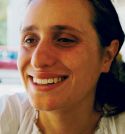UCT graduate recipient of international literary award
24 February 2003 Visualizing the invisible: UCT Fine Art graduate and winner of the 2002 Golden Key International Honour Society Non-Fiction Literary Achievement Award, Anya Subotzky.
Visualizing the invisible: UCT Fine Art graduate and winner of the 2002 Golden Key International Honour Society Non-Fiction Literary Achievement Award, Anya Subotzky.
UCT FINE ART and psychology graduate Anya Subotzky was recently named winner of the 2002 Golden Key International Honour Society Literary Achievement Awards in the category of non-fiction.
Her submission, Visualizing the Invisible: The Role of Images in South African Responses to HIV/AIDS, was deemed most outstanding by a panel of professors in the field of literature. In recognition, she received a scholarship worth R8Â 387 and was published in the Society's Concepts magazine. Subotzky was selected from a pool of 500 candidates from around the globe.
The Golden Key International Honour Society, a global non-profit Society, provides not only academic recognition to university undergraduates and postgraduates in the top 15% of their class, but also leadership opportunities, community service, career networking and scholarships. The Society has 335 chapters in the US, Australia, Canada, UK, Malaysia, South Africa and New Zealand. Membership into the Society is by invitation only, to students in all fields of study.
Subotzky's paper was originally written for her third year Theory of Art course, and examines ways in which “the historically significant relationship between the realms of the aesthetic and the pathological– have acquired a new import in the current eraâ€.
She begins her paper by posing the now well-acknowledged question of why high levels of knowledge about the disease have not curbed escalating infection rates in this country. The answers, she says, “seems to lie in the problematic assumption that information will lead rationally to behaviour changeâ€, what she terms a “rational fallacyâ€. This leads to an argument for the use of images “in their capacity to communicate in ways which transcend rationalityâ€.
However, in her subsequent analysis of the functions and implications of three manifestations of AIDS-related imagery in South Africa, she finds that this does not always prove the case.
Firstly, she argues that local awareness campaigns, “seem to reinforce rather than erode stereotypes, and recapitulate existing power relations rather than challenging themâ€.
Secondly, she theorises that there appears to be a tendency for mainstream artistic responses to remain peripheral, in much the same way that AIDS has traditionally been associated with marginal groups, and in keeping with the widely noted tendency to externalise the disease.
Thirdly, she is more positive about the use of images in the Memory Box Project, as both therapeutic interventions and advocacy tools for treatment and care. In conclusion, Subotzky argues for “the need for a new visual response to a disease characterised as invisibleâ€.
The body of work which made up Subotzky's graduate exhibition at the Michaelis School of Fine Art in December last year drew on similar themes, and included a series of paintings produced in collaboration with Libuseng Potsane, a Khayelitsha woman living openly with HIV, and suffering, like herself, from an itchy skin condition.
“Amid many marked differences between us, this common experience of a ruptured skin became a central motif in our work together,†Subotzky explained. In her exhibition catalogue she notes that the relationship between suffering and the notion of limits is central to her body of work.
“More specifically, frayed boundaries are conceived as ambiguously indicative of suffering and of healing, both of the individual body and the broader body politic.†Skin is explored as “both interface between self and other, inside and outside, visible and invisible, and inscriptive surface onto which this suffering is projectedâ€.
Subotzky explained that her growing engagement with HIV/AIDS stems in part from the involvement of family members in this field. “My uncle is photographer Gideon Mendel who has been working with AIDS in Africa over the past 10 years, and my mother, Eve, is a medical doctor who is facing the enormity of the epidemic on a daily basis. I have grown up with their stories.â€
Subotzky is drawing on this background, as well as that of art and psychology, in her current work with the Memory Box Project of the AIDS and Society Research Unit (ASRU) at UCT, where she is facing new and exciting challenges in these fields.
 This work is licensed under a Creative Commons Attribution-NoDerivatives 4.0 International License.
This work is licensed under a Creative Commons Attribution-NoDerivatives 4.0 International License.
Please view the republishing articles page for more information.
Related
Alderman Owen Kinahan (1955–2026)
06 Jan 2026
Celebrating UCT’s outstanding Thuthuka results
29 Dec 2025










